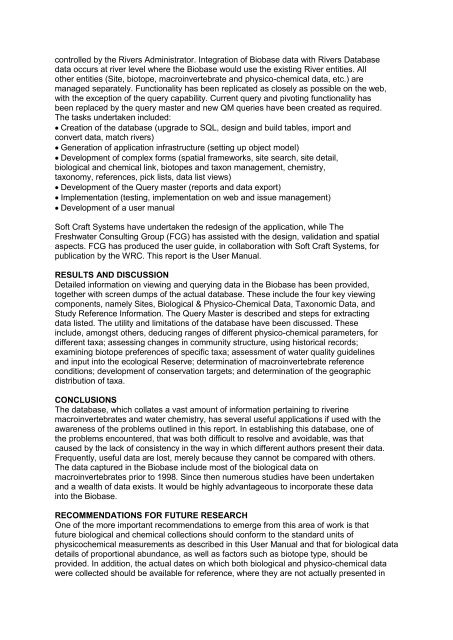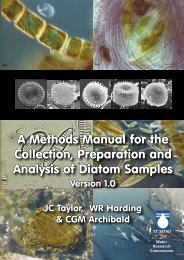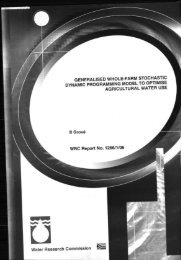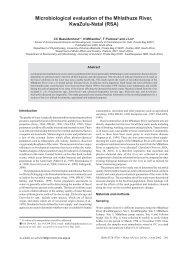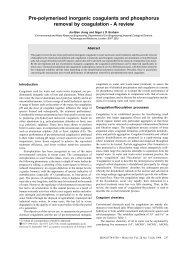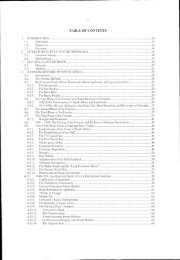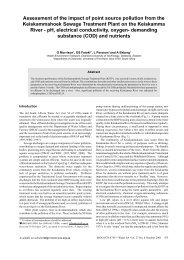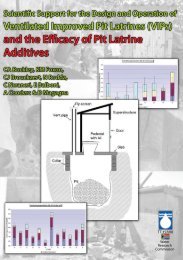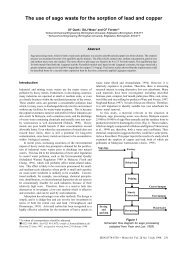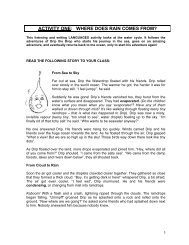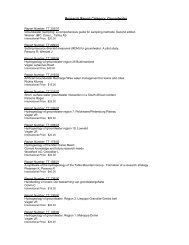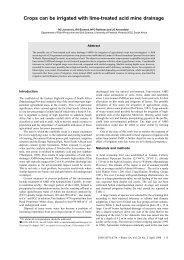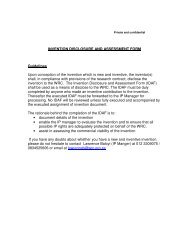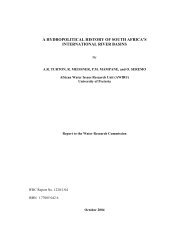EXECUTIVE SUMMARY for KV 262.pdf - Water Research Commission
EXECUTIVE SUMMARY for KV 262.pdf - Water Research Commission
EXECUTIVE SUMMARY for KV 262.pdf - Water Research Commission
You also want an ePaper? Increase the reach of your titles
YUMPU automatically turns print PDFs into web optimized ePapers that Google loves.
controlled by the Rivers Administrator. Integration of Biobase data with Rivers Database<br />
data occurs at river level where the Biobase would use the existing River entities. All<br />
other entities (Site, biotope, macroinvertebrate and physico-chemical data, etc.) are<br />
managed separately. Functionality has been replicated as closely as possible on the web,<br />
with the exception of the query capability. Current query and pivoting functionality has<br />
been replaced by the query master and new QM queries have been created as required.<br />
The tasks undertaken included:<br />
Creation of the database (upgrade to SQL, design and build tables, import and<br />
convert data, match rivers)<br />
Generation of application infrastructure (setting up object model)<br />
Development of complex <strong>for</strong>ms (spatial frameworks, site search, site detail,<br />
biological and chemical link, biotopes and taxon management, chemistry,<br />
taxonomy, references, pick lists, data list views)<br />
Development of the Query master (reports and data export)<br />
Implementation (testing, implementation on web and issue management)<br />
Development of a user manual<br />
Soft Craft Systems have undertaken the redesign of the application, while The<br />
Freshwater Consulting Group (FCG) has assisted with the design, validation and spatial<br />
aspects. FCG has produced the user guide, in collaboration with Soft Craft Systems, <strong>for</strong><br />
publication by the WRC. This report is the User Manual.<br />
RESULTS AND DISCUSSION<br />
Detailed in<strong>for</strong>mation on viewing and querying data in the Biobase has been provided,<br />
together with screen dumps of the actual database. These include the four key viewing<br />
components, namely Sites, Biological & Physico-Chemical Data, Taxonomic Data, and<br />
Study Reference In<strong>for</strong>mation. The Query Master is described and steps <strong>for</strong> extracting<br />
data listed. The utility and limitations of the database have been discussed. These<br />
include, amongst others, deducing ranges of different physico-chemical parameters, <strong>for</strong><br />
different taxa; assessing changes in community structure, using historical records;<br />
examining biotope preferences of specific taxa; assessment of water quality guidelines<br />
and input into the ecological Reserve; determination of macroinvertebrate reference<br />
conditions; development of conservation targets; and determination of the geographic<br />
distribution of taxa.<br />
CONCLUSIONS<br />
The database, which collates a vast amount of in<strong>for</strong>mation pertaining to riverine<br />
macroinvertebrates and water chemistry, has several useful applications if used with the<br />
awareness of the problems outlined in this report. In establishing this database, one of<br />
the problems encountered, that was both difficult to resolve and avoidable, was that<br />
caused by the lack of consistency in the way in which different authors present their data.<br />
Frequently, useful data are lost, merely because they cannot be compared with others.<br />
The data captured in the Biobase include most of the biological data on<br />
macroinvertebrates prior to 1998. Since then numerous studies have been undertaken<br />
and a wealth of data exists. It would be highly advantageous to incorporate these data<br />
into the Biobase.<br />
RECOMMENDATIONS FOR FUTURE RESEARCH<br />
One of the more important recommendations to emerge from this area of work is that<br />
future biological and chemical collections should con<strong>for</strong>m to the standard units of<br />
physicochemical measurements as described in this User Manual and that <strong>for</strong> biological data<br />
details of proportional abundance, as well as factors such as biotope type, should be<br />
provided. In addition, the actual dates on which both biological and physico-chemical data<br />
were collected should be available <strong>for</strong> reference, where they are not actually presented in


